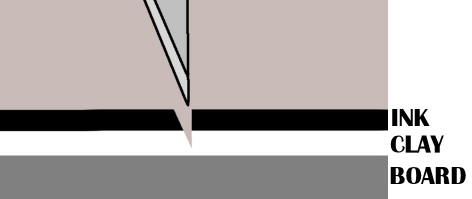scratchboard on:
[Wikipedia]
[Google]
[Amazon]
Scratchboard or scraperboard or scratch art is a form of direct engraving where the artist scratches off dark ink to reveal a white or colored layer beneath. The technique uses sharp knives and tools for engraving into the scratchboard, which is usually cardboard covered in a thin layer of white
 Unlike many drawing media, where the artist adds in the mid-tones and shadows, with scratchboard the artist is working by adding in the highlights.
The artist can use a variety of tools to scratch away the black ink from the board and reveal more or less of the white clay that is underneath. Effects include
Unlike many drawing media, where the artist adds in the mid-tones and shadows, with scratchboard the artist is working by adding in the highlights.
The artist can use a variety of tools to scratch away the black ink from the board and reveal more or less of the white clay that is underneath. Effects include
File:Lee Sunflower and silver.jpg, ''Sunflower and Silver'' by Diana Lee
File:Lee Sunflower and silver detail.jpg, A detail of ''Sunflower and Silver'' to show scratching technique
China clay
Kaolinite ( ; also called kaolin) is a clay mineral, with the chemical composition aluminium, Al2Silicon, Si2Oxygen, O5(hydroxide, OH)4. It is a layered silicate mineral, with one tetrahedron, tetrahedral sheet of silica () linked through oxygen ...
coated with black India ink
India ink (British English: Indian ink; also Chinese ink) is a simple black or coloured ink once widely used for writing and printing and now more commonly used for drawing and outlining, especially when inking comic books and comic strips. In ...
. Scratchboard can yield highly detailed, precise and evenly textured artwork. Works can be left black and white, or colored.
History
Modern scraperboard originated in the 19th century in Britain and France. As printing methods developed, scraperboard became a popular medium for reproduction replacingwood engraving
Wood engraving is a printmaking technique, in which an artist works an image into a block of wood. Functionally a variety of woodcut, it uses relief printing, where the artist applies ink to the face of the block and prints using relatively l ...
, metal engraving, and linocut
Linocut, also known as lino print, lino printing or linoleum art, is a printmaking technique, a variant of relief printing in which a sheet of linoleum (sometimes mounted on a wooden block) is used for a relief printing, relief surface. A design i ...
. It allowed for a fine line appearance that could be photographically reduced for reproduction without losing quality. It was most effective and expeditious for use in single-color book and newspaper printing. From the 1930s to 1950s, it was a preferred technique for medical, scientific and product illustration. During that period, Virgil Finlay made detailed illustrations, often combining scraperboard methods with traditional pen & ink technique. More recently, it has been used for editorial illustrators of magazines, ads, graphic novels
A graphic novel is a self-contained, book-length form of sequential art. The term ''graphic novel'' is often applied broadly, including fiction, non-fiction, and anthologized work, though this practice is highly contested by comics scholars and ...
, and one of a kind pieces of fine art.
Technique
 Unlike many drawing media, where the artist adds in the mid-tones and shadows, with scratchboard the artist is working by adding in the highlights.
The artist can use a variety of tools to scratch away the black ink from the board and reveal more or less of the white clay that is underneath. Effects include
Unlike many drawing media, where the artist adds in the mid-tones and shadows, with scratchboard the artist is working by adding in the highlights.
The artist can use a variety of tools to scratch away the black ink from the board and reveal more or less of the white clay that is underneath. Effects include stippling
Stippling is the creation of a pattern simulating varying Grayscale, degrees of solidity or shading by using small dots. Such a pattern may occur in nature and these effects are frequently emulated by artists.
Art
In printmaking, stipple ...
by poking the board with a needle or blade, and scratching or cross-hatching using a sharp blade.
Artists
Illustrators who have worked in the scratchboard medium include Michael McCurdy, Peter Blake, Virgil Finlay, John Schoenherr, Jos Sances, Sven Rayen and Scott McKowen. The comics artist Jacques Tardi used scratchboard to illustrateJules Verne
Jules Gabriel Verne (;''Longman Pronunciation Dictionary''. ; 8 February 1828 – 24 March 1905) was a French novelist, poet and playwright.
His collaboration with the publisher Pierre-Jules Hetzel led to the creation of the ''Voyages extraor ...
's science fiction
Science fiction (often shortened to sci-fi or abbreviated SF) is a genre of speculative fiction that deals with imaginative and futuristic concepts. These concepts may include information technology and robotics, biological manipulations, space ...
in the style of 19th century woodcuts. illustrated in scratchboard the adult non-fiction book, '' Why Fish Don't Exist'' by Lulu Miller.
In 2011, the International Society of Scratchboard Artists was launched to help promote scratchboard art, and to educate the public about the medium. The organization holds an annual exhibition of scratchboard art.
References
Further reading
* * * * Cutler, Merritt Dana, ''Scratchboard Drawing'', 1949, Watson-Guptill Publications. * Cutler, Merritt Dana, "How to Cut Drawings on Scratchboard", 1960, Watson-Guptill Publications, * Lozner, Ruth, ''Scratchboard for Illustration'', 1990, Watson-Guptill Publications, {{ISBN, 0-8230-4662-1 Drawing Artistic techniques